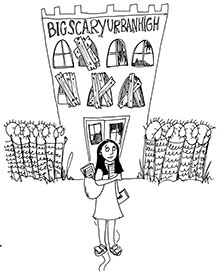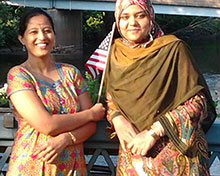
"The field" is the focus of this week's blog. The "field" is on my mind because often the requests I receive for input into qualitative or mixed methods research are about how to conduct interviews with people who are leading very interesting lives. The standard location where interviews are recorded is a quiet confidential place – like an office. What people choose to tell about their lives – how they represent themselves in that place and with the researcher - is interesting and important. However it’s not always the entire picture when we want to understand more fully the context of their lives, the social meaning of what they choose to tell, and what they have forgotten or choose to leave out. To understand these matters we must "go to the field" or "do fieldwork".
 Fieldwork is a term that observational scientists and social workers use that mean conducting observations and other forms of data collection, or providing services in places where activities actually take place and where people live, learn and work. Like collecting data from "respondents" in an office setting, however, simply collecting data in other locations is does not mean that researchers are “in the field”.
Fieldwork is a term that observational scientists and social workers use that mean conducting observations and other forms of data collection, or providing services in places where activities actually take place and where people live, learn and work. Like collecting data from "respondents" in an office setting, however, simply collecting data in other locations is does not mean that researchers are “in the field”.
From a research perspective, the "field", is that place where people enact their daily lives, work, and social relationships and their risk behavior. The notion of "field" signifies a place that is unfamiliar to the researcher, perhaps perceived as risky or threatening or at the very least different and uncomfortable. Going to the field means stepping out of everyday life into the everyday lives of others, entering a place where the role of researcher has no cache. Entering into other worlds can be very stressful, requiring new demands on our social skills, understanding and speaking new languages, and relating to those with whom our paths don’t necessarily cross. The "field" is where WE are different and those in the setting may be uncomfortable with us and may not necessarily like or trust us. While some researchers are drawn to new people, places and experiences, and thrive on the challenge of confronting novelty, others are less so. In familiar environments where the field is a neighborhood in San Francisco or a low income community in Mumbai or a center for women who have experienced violence, cities in which researchers live, it’s easy enough to procrastinate while having a coffee. "I'll go tomorrow"; "she won't be there right now" "it's raining" – and make contact later.
But in distant or very unfamiliar places, far away, researchers can experience great discomfort, and occasionally someone will return from a distant place to the safety of the home country.
 Even a familiar setting can be transformed to a "field setting" by making it fresh and different, by imagining that all the rules of behavior in the setting need to be newly learned and interpreted. A colleague of mine used to send his methods students to ride the bus and describe what they saw. Some of the students had never ridden the bus in their lives; others grew up riding the bus. Both groups had reservations about doing so – "what to pay, what to observe, where to sit, whether to take notes, how to talk to people, what to learn about, what about looking conspicuous". Riding the bus is a metaphor for structured serendipity – there is a place, there are rules of behavior, there is pattern to be discovered, there are anticipated class and other inequities represented; but there is also the excitement and dis-ease in entering and observing in a new environment, and the surprise of the unanticipated event or interaction that can tell us something about how rules, pattern, power and hierarchy work and about the generosity and responsiveness of humans in relation to each other.
Even a familiar setting can be transformed to a "field setting" by making it fresh and different, by imagining that all the rules of behavior in the setting need to be newly learned and interpreted. A colleague of mine used to send his methods students to ride the bus and describe what they saw. Some of the students had never ridden the bus in their lives; others grew up riding the bus. Both groups had reservations about doing so – "what to pay, what to observe, where to sit, whether to take notes, how to talk to people, what to learn about, what about looking conspicuous". Riding the bus is a metaphor for structured serendipity – there is a place, there are rules of behavior, there is pattern to be discovered, there are anticipated class and other inequities represented; but there is also the excitement and dis-ease in entering and observing in a new environment, and the surprise of the unanticipated event or interaction that can tell us something about how rules, pattern, power and hierarchy work and about the generosity and responsiveness of humans in relation to each other.
So why go to the field when we can interview or get others to interview for us. First, we must believe that something about the setting is important in understanding human behavior. If we believe that context matters, we want to make as many observations as possible about the setting that could have implications for people's lifestyles, interactions, transmission of information, and quality of life. For example, we can learn from residents of senior housing how they describe their interactions with other residents. But when we are actually spending time in their building (the "field setting"), we can SEE how they interact and with whom, we can observe the nature and quality of their interaction, and we can use continuous comparisons over time and place to note how patterns of interaction change throughout the day, in hallways, meeting rooms, and in informal gathering places. And we can ask them about it. Familiarity with ongoing social life in the building helps to build needed relationships for further work, and to develop more insightful indepth interviews and survey questions. Equally important, residents can see and interact with researchers on their turf. We can share a common humanity.
 Being "in the field" entails ongoing presence which requires communication with and permissions from people who control or manage the study setting and people who use it. It means explaining why we are there, what we hope to learn, how we hope to learn it, and how those observed or interviewed might or might not benefit from the interaction. It puts us on the spot. Often in the early stages of a field experience, we have to introduce ourselves and our projects, over and over again to new people and the same people who may ask different questions each time they see us as they deepen their relationships with us. In the field, informed consent is ongoing. In this way the field experience also enables us to establish transparency and trust with people in their own communities, homes and schools, especially when we researchers are noticeably different from those who live and work in the setting.
Being "in the field" entails ongoing presence which requires communication with and permissions from people who control or manage the study setting and people who use it. It means explaining why we are there, what we hope to learn, how we hope to learn it, and how those observed or interviewed might or might not benefit from the interaction. It puts us on the spot. Often in the early stages of a field experience, we have to introduce ourselves and our projects, over and over again to new people and the same people who may ask different questions each time they see us as they deepen their relationships with us. In the field, informed consent is ongoing. In this way the field experience also enables us to establish transparency and trust with people in their own communities, homes and schools, especially when we researchers are noticeably different from those who live and work in the setting.
Being "in the field" means learning through direct experience as well as narratives and survey data. Ethnographers refer to this process as participant observation. What they mean is that researchers learn through embodied presence and practice how to conduct themselves as members of that cultural or community setting as best they can, depending on their positionality (who they are, how much power they are perceived as having through race/ethnicity, age, education etc., their gender, religious affiliation, and activity preferences) and what steps they are able to take to overcome or compensate for these potential differences. This socialization process depends on establishing close personal relationships with others in the setting who can provide guidance, explanation and friendship. It is very difficult for empirical researchers who believe that emotional and social distance produce unbiased objectivity.
 In fact, the more researchers come to know people in the setting, the more likely they are to be accurate in both their observations and interpretations because they have been taught to see and to question reality by experienced local people who may in some cases become their research partners. Field experience delimits and controls bias.
In fact, the more researchers come to know people in the setting, the more likely they are to be accurate in both their observations and interpretations because they have been taught to see and to question reality by experienced local people who may in some cases become their research partners. Field experience delimits and controls bias.
Going to the field, being in the field and leaving the field are a lot of trouble. Why should we take the time to leave familiar territory when we can simply hold a few focus groups arranged by managers in a setting, or arrange for students or field staff to administer surveys or interviews? Because learning through engagement is the first critical step in developing good research questions, finding good research partners, breaking down class, racial/ethnic and other social barriers, developing culturally valid and reliable measures, and integrating the results of our research into local change processes. Finally it teaches us how to act with humility and an open mind in a diverse and complex world.
Many good resources are available to assist researchers to maximize their capacity to identify their "field", enter it effectively, build ongoing working relationships and collect mixed methods data on their research topics. Some are:
Schensul, S., Schensul J and M.D. LeCompte.2012. Initiating Ethnographic Research: Models, Methods, And Measurement; A Mixed Methods Approach, Book 2, Ethnographer's Toolkit, Lanham, MD.: AltaMira Press, especially chapter 3, Preparing for Challenges in the Field.
Blommaert, Jan, Dong, Jie. 2011. Ethnographic Fieldwork: A Beginner's Guide. Multilingual Matters.

